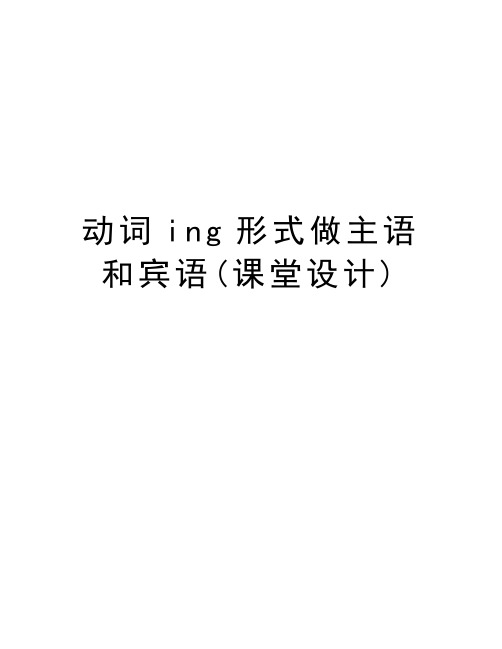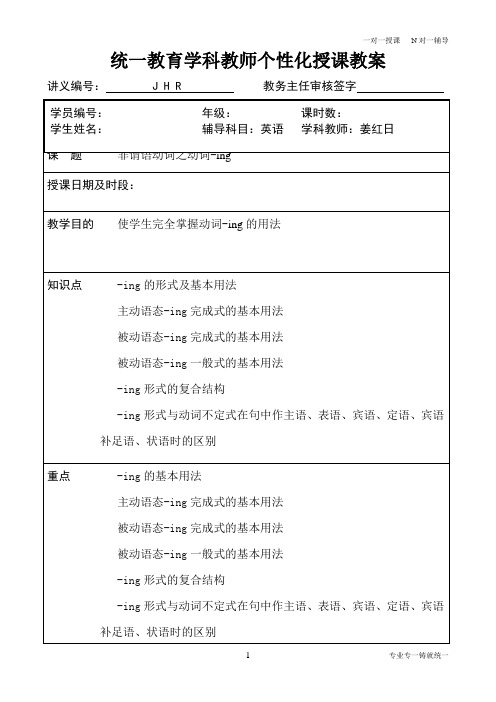动词ing形式做主语和宾语(课堂设计)
动词-ing形式作主语和宾语

一、动词-ing形式作主语和宾语考点一:动词-ing形式的基本用法动词-ing具有名词的性质,可在句中担当主语、宾语、标语、定语、宾语补足语和状语,动词-ing形式作主语常用来表示经常性和习惯性的动作。
动词-ing形式作主语通常放在句首。
但不能单独做谓语。
考点二:动词-ing做主语的用法:1)动词-ing作主语时,往往表示习惯性、经常性的动作,在口语中也表示具体的动作。
如:Paiting is his hobby.2)动词-ing形式作主语和不定式作主语一样,也可以用it做形式主语,但不定式作主语往往表示具体的特别是将来的动作。
如:It is no use talking without doing.光说不做是没用的It is so hot. what I want to do now is to have a swim in a river.天这么热,现在我想做的事情就是在河里游泳。
动词-ing形式作主语时,为了保持句子平衡,可以用it作形式主语。
常用的结构:1. It is + no use / no good / useless etc.+ v-ing2. It is + nice / good / interesting / a waste of…etc. + v-ing例如:It is no use crying over spilt milk.事考点三:动词-ing形式作宾语的用法1.有些动词或动词短语常用动词-ing形式作宾语:admit,avoid,appreciate,consider,enjoy,escape,finish,keep,mind, miss, suggest等动词; can’t stand, give up, feel like, keepon, think of, set about, dream of等短语。
避免错过少延期建议完成多练习喜欢想象禁不住承认否定与嫉妒逃避冒险xxxx忍受保持不介意考虑欣赏还愿意2.在下列短语中,to是介词,后面应用动词-ing形式作宾语:be / get us ed to, look forward to, devote…to, pay attention to,object to等。
语法复习动词ing形式作主语和宾语课件

详细描述
列出多个句子,其中一些句子含有动词-ing形式作主语或宾语,一些句子则没有,让学 生从中选择正确的句子。
段落写作练习
总结词
提升应用能力
VS
详细描述
布置一个主题或情境,要求学生使用动词 -ing形式作主语和宾语进行段落写作,以 锻炼他们的语言组织和应用能力。
感谢您的观看
THANKS
定义
动词-ing形式作宾语是指动词以ing形式作为句中的宾语成分,常 出现在句子的谓语动词之后。
特点
动词-ing形式作宾语具有进行时 态的特点,表示动作正在进行或 持续发生。
常见句型结构
主语 + 谓语 + 动词ing形式作宾语
主语 + 谓语 + 间接 宾语/直接宾语(动 词-ing形式)
主语 + 系动词 + 表 语(动词-ing形式)
语法复习动词ing形 式作主语和宾语课件
目录
CONTENTS
• 动词-ing形式作主语 • 动词-ing形式作宾语 • 动词-ing形式作主语和宾语的用法 • 动词-ing形式作主语和宾语的注意事项 • 动词-ing形式作主语和宾语的练习与巩
固
01 动词-ing形式作主语
定义与特点
定义
动词-ing形式作主语指的是在英语句子中,使用动词的-ing 形式作为句子的主语,表示该动作或行为是句子所描述的对 象。
特点
动词-ing形式作主语具有描述性、动态性和进行性的特点, 能够生动地描述某个动作或行为的正在进行状态,强调该动 作或行为的持续性、过程性和特征。
常见句型结构
“It + be + -ing + that从句”结构
20-21版:Grammar——动词-ing形式作主语和宾语(创新设计)

Yesterday being Sunday postponed the match. 昨天是星期天,比赛推迟了。(作主语) She is fond of coffee being served after dinner. 她喜欢饭后喝点咖啡。(作宾语)
14
@《创新设计》
本节内容结束
15
8
@《创新设计》
5.有些动词,后接动词-ing形式作宾语,与用动词不定式作宾语,意义大相径庭。
try to do sth尽力做某事
try doing sth
试着做某事
mean to do sth打算/意欲做某事
mean doing sth
意味着某事
forget to do sth忘记去做某事
forget doing sth
4
2.置于句末,用it作形式主语,多见于下面几个句型: It is worth doing...做……是值得的 It+be+a waste of time doing...做……是浪费时间的 It is/was no good/use doing...做……是没有好处/用处的 It is a waste of time talking about such useless things. 谈论这些没用的事情是在浪费时间。 It is no use crying over spilt milk. 覆水难收。
12
@《创新设计》
③代词宾格+动词-ing Can you imagine him/Jack cooking at home? 你能想象他/杰克在家做饭的样子吗? ④名词+动词-ing The baby was made awake by the door suddenly shutting. 这个婴儿被突然的关门声吵醒了。 [名师点津] (1)动词-ing形式的复合结构可在句中作主语或宾语。作主语时,不能用③④两种形式。 (2)无生命名词无论是作主语还是作宾语都不能用第②种形式。
动词ing形式做主语和宾语(课堂设计)备课讲稿

动词i n g形式做主语和宾语(课堂设计)The -ing form as the Subject and the Object教学设计Contents 教学内容Discovering useful structures(p.13); Using structures (p. 50)Teaching goals 教学目标1,Enable students to use the –ing form as subject and object correctly and freely.2.How to use the-ing form freely .Explaining , discussing and practicing .The importance and difficulties教学重点、难点1. Inspire Ss to discover the differenxes.2. Make Ss remenber the different predicate verbs.课前导学DiscoveringThe following sentences are from the text. There are some useful structures in them . Let students translate them and pay attention to these boldface words .1,he cares little about spending the money on himself or leadinga comfortable life . (The Object)2.He also doesn’t care about being famous. (The Object)3.His other hobbies include playing mah-jong ,swimming andreading .4.Wishing for things , however , costs noting .(The Object)5.Since then , finding ways to grow more rice has been his lifegoal .(The Subject)6.As a young man , he saw the great need for increasing the rice output . (The Object)7.Dr Yuan searched for a way to increase rice harvests without expanding the area of the fields .(The Object)8.Dr Yuan awoke from his dream with the hope of producing a kindof rice that could feed more people .(The Object)以学定教/展示激学 Teaching procedureStep 1 Warming upHave you ever seen these signs?What about these sentences?1. Saying is easy. Doing is difficult.2. Seeing is believing.3. Teaching is learning.4. Lying is a bad habit.5. Getting daily exercise is important.6. Learning English needs persistence.Step 2 As the SubjectPart 1 Pay attention to the following boldface words.plaining doesn't solve problems.2.Smoking causes a lot of health problems.3.To him, swimming is much fun.4.Talking mends no holes.5.Raising children is a big responsibility.6.Climbing the mountain in winter is dangerous.7.Asking a woman's age is impolite in my country.8.Riding with a drunken driver is a risk.9.Working hard will produce good results.10.Speaking in public is a challenge to a lot of people.Summary:The -ing form can be used as the subject.It can have its own object and adverbial. And the predicate verb is used singular form. Part 2 Pay attention to it(一)1) It is a waste of time doing this.→2) It is no use crying over spilt milk.→3) It is no use complaining.→4) It is no good worrying about it.→5) It is difficult finding your way around here?→Summary : It一是可以用It作形式主语;二是动词-ing形式可以有逻辑主语(即独立主格结构),三是可以有否定形式。
动词ing教案

统一教育学科教师个性化授课教案讲义编号: J H R 教务主任审核签字27. Most of the artists ______ to the party 'were from South Africa.A. invitedB. to inviteC. being invitedD. had been invited28. English is a language ______ in many countries.A. spokenB. speakingC. be spokenD. to speak29. "Can you read?" Mary said to the notice.A. angrily, pointingB. and point angrilyC. angrily, pointedD. and angrilypointing30. There was a terrible noise _______ the sudden burst of Tight.A. followedB. followingC. to be followedD. being followed31. ____ more attention, the trees could have grown better.A. GivenB. To giveC. GivingD. Having given32. _____their students, the famous teacher came into the hall.A. FollowedB. Followed byC. Being followedD. Having been followed33. Your flat needs _____ . Would you like me it for you?A. to clean, to doB. cleaning, doingC. cleaning, to doD. to be cleaned, doing34. Does your new secretary ____ short hand?A. know to takeB. know how to takeC. know how takeD. know how taking35. Tommy had his big brother _____ his shoes for him.A. to tieB. tieC. tiedD. tying36. Would you please ______ write on the textbooks?A. don'tB. not toC. notD. to not37. I'd ______ the operation unless it is absolutely necessary.A. rather not haveB. rather not to haveC. not rather hadD. rather not having38. Your mother and I are looking forward________ you.A. of seeingB. for seeingC. to seeD. to seeing39. The girl couldn't_____ how red his face was.A. help to noticeB. be helping to noticeC. be helping noticingD. help noticing40. Excuse me, but it is time to have your temperature ______.A. takingB. to takeC. takeD. taken1~5 CDDAB6~10 BAACB11~15 BCADC16~20 BCCDB21~25 CDDAD 26~30 DAAAB 31~35 ABCBB 36~40 CADDD。
动词ing形式作主语和宾语PPT课件

3
动词-ing形式作主语 谓语动词用 单数。如:
Reading aloud is very important
for us to learn a foreign
language.
Going to bed early and getting up
early is considered to be a good
8
• 我们可以归纳总结出动词 -ing形式作宾语的用法特 征:
• 有些动词后常跟动词ing形式作宾语,如第三 组例句中的suggest和 consider。常见的这类动 词还有:
9
常跟动词ing作宾语的动词歌诀:
考虑建议 consider, suggest / 盼原谅, advise ,look forward
habit.
4
2. A. It’s no use talking to him; he won’t change his mind.
B. It is simply a waste of time discussing such matters with him.
5
在句型It’s + no good (no use, useless,a waste of time, nice ...) + doing sth.中,it是形式主语, 后面的动词-ing(短语) 作真正的主语。
13
5 “There is + no”后可以用动词-ing 形式作主语,表示“没法……”。 如:
There was no telling when this might happen again. 没法预料这 样的事什么时候会再发生。
动词ing做主语和宾语带句子成分讲解版PPT课件

精选ppt课件最新
11
基本句型 二 此句型的句子有一个共同的特点:句 子谓语动词都不能表达一个完整的意 思,必须加上一个表明主语身份或状 态的表语构成复合谓语,才能表达完 整的意思。
精选ppt课件最新
12
这类动词叫做连系动词。系动词分 两类:be, look, keep, seem等属 一类,表示情况;get, grow, become, turn等属另一类,表示 变化。be 本身没有什么意义,只起 连系主语和表语的作用。其它系动 词仍保持其部分词义。
什么叫句子成分呢?句子的组成成
分叫句子成分。句子成分由词或词组充当。
现代汉语里一般的句子成分有六种,即主
语、谓语、宾语、定语、状语和补语。英
语的基本成分有六种:主语(subject)、
谓语(predicate)、表语(predicative)、
宾语(object)、定语(attribute)和状语
(adverbial)。
钻牛角尖,否则就会事倍功半。各种语言有各
自的规则、各自的习惯,而且语言是很灵活的
东西,发展过程也很复杂,很难把语法的现象
都做出明确、统一的解释来。在使用一种语言
时,语法应让位于习惯。符合习惯的,有时尽
管不符合语法,也是精正选ppt确课件最的新 。
7
英语句子有长在短,有简有 繁,从现象看,似乎千变万化,难 以捉摸,但从实质看,可以发现其 内在联系,找出其共同规律。英语 句子的基本结构可以归纳成五种基 本句型及其扩大、组合、省略或倒 装。掌握这五种基本句型,是掌握 各种英语句子结构的基础。
= n. pron.
现在分词:P. Attributive. C.
Adverbial
= adj. adv.
动词ing做主语和宾语(带句子成分讲解版)

英语句子有长在短,有简有繁,从现象看, 似乎千变万化,难以捉摸,但从实质看,可 以发现其内在联系,找出其共同规律。英语 句子的基本结构可以归纳成五种基本句型及 其扩大、组合、省略或倒装。掌握这五种基 本句型,是掌握各种英语句子结构的基础。
英语五种基本 句型列式如下 :
S V (主+谓) S V P (主+谓+表) S V O (主+谓+宾) S V o O (主+谓+间宾+直宾) S V O C (主+谓+宾+宾补)
4. 我们发现大礼堂坐满了学生和教师,在听一个重要报告。
We found the great hall full of students and teachers listening to an important report made by a comrade from the People's Daily on current affairs in East Europe.
bus.
但常用的英语句子并不都象基本句型这样简短,这 些句子除了基本句型的成分不变外,通常是在这些 成分的前面或后面增加一些修饰语(modifier)而 加以扩大。这些修饰语可以是单词(主要是形容词、 副词和数词),也可以是
各种类型的短语(主要是介词短语、不定式短语和 分词短语)。
1. 下面以基本句型五为例:
5
Who │cares?
6
What he said │ does not matter.
7
They │ talked for half an hour.
8
The pen │writes smoothly
基本句型 二
此句型的句子有一个共同的特点:句子谓 语动词都不能表达一个完整的意思,必须 加上一个表明主语身份或状态的表语构成 复合谓语,才能表达完整的意思。
- 1、下载文档前请自行甄别文档内容的完整性,平台不提供额外的编辑、内容补充、找答案等附加服务。
- 2、"仅部分预览"的文档,不可在线预览部分如存在完整性等问题,可反馈申请退款(可完整预览的文档不适用该条件!)。
- 3、如文档侵犯您的权益,请联系客服反馈,我们会尽快为您处理(人工客服工作时间:9:00-18:30)。
The -ing form as the Subject and the Object教学设计Contents 教学内容Discovering useful structures(p.13); Using structures (p. 50)Teaching goals 教学目标1,Enable students to use the –ing form as subject and objectcorrectly and freely.2.How to use the-ing form freely .Explaining , discussing andpracticing .The importance and difficulties教学重点、难点1. Inspire Ss to discover the differenxes.2. Make Ss remenber the different predicate verbs.课前导学DiscoveringThe following sentences are from the text. There are some usefulstructures in them . Let students translate them and pay attention to theseboldface words .1,he cares little about spending the money on himself or leading acomfortable life . (The Object)2.He also doesn’t care about being famous. (The Object)3.His other hobbies include playing mah-jong ,swimming and reading.4.Wishing for things , however , costs noting .(The Object)5.Since then ,finding ways to grow more rice has been his life goal .(The Subject)6.As a young man , he saw the great need for increasing the rice output .(The Object)7.Dr Yuan searched for a way to increase rice harvests withoutexpanding the area of the fields .(The Object)8.Dr Yuan awoke from his dream with the hope of producing a kind ofrice that could feed more people .(The Object)以学定教/展示激学 Teaching procedureStep 1 Warming upHave you ever seen these signs?What about these sentences?1. Saying is easy. Doing is difficult.2. Seeing is believing.3. Teaching is learning.4. Lying is a bad habit.5. Getting daily exercise is important.6. Learning English needs persistence.Step 2 As the SubjectPart 1 Pay attention to the following boldface words.plaining doesn't solve problems.2.Smoking causes a lot of health problems.3.To him, swimming is much fun.4.Talking mends no holes.5.Raising children is a big responsibility.6.Climbing the mountain in winter is dangerous.7.Asking a woman's age is impolite in my country.8.Riding with a drunken driver is a risk.9.Working hard will produce good results.10.Speaking in public is a challenge to a lot of people.Summary:The -ing form can be used as the subject.It can have its own object and adverbial. And the predicate verb is used singular form.Part 2 Pay attention to it(一)1) It is a waste of time doing this.→2) It is no use crying over spilt milk.→3) It is no use complaining.→4) It is no good worrying about it.→5) It is difficult finding your way around here?→Summary : It一是可以用It作形式主语;二是动词-ing形式可以有逻辑主语(即独立主格结构),三是可以有否定形式。
(二)It is my duty helping her.→Helping her is my duty.It is a pleasure working with you .→Working with you is a pleasure. Transform the sentences in (一 ) (ommitted)ConsolidationA.1.Losing (lose) someone you love is a painful experience.2.Falling (fall) in love is easy. Staying(stay) in love is hard.3.Eating (eat) to live is more meaningful than living (live) to eat.4.Getting (get) married costs a lot. Getting (get) divorced costs much more.5.Spending (spend) money is easier than making (make) money.B.做课本练习2(p. 13)。
巩固动词-ing形式作主语的用法。
Step 3 As the ObjectPart 1 1. Read the the following sentences you found out from the text and try to find some rules.1) As a young man, he saw the great need for increasing the rice output.2) Dr Yuan searched for a way to increase rice harvests without expanding the area of the fields.3) He enjoys listening to violin music, playing mah-jong, swimming and reading.4) Dr Yuan awoke from his dream with the hope of producing a kind of rice that could feed more people.Summary:The -ing form can be used as the object both of verb and preposition.2. Look at the following sentences. What have you found?1) He suggested doing it in a different way.2) The president tried to avoid answering the reporter’s questions.3) I admit having read your letter.4)We’re considering paying a visit to the Science Museum.5)I have been used to living here.6) I’m fond of collecting stamps and coins.7) Mom agreed to lend me some money.8) Jack pretended not to see me when he passed.9) My friend offered to help when I was in trouble.Summary:1). Verbs with –ing form as their object:admit, advise, allow, appreciate, avoid, complete, consider, delay, deny, enjoy, escape, finish, imagine, keep, mind, miss, postpone, practise, quit, suggest, stop, can’t stand, can’t help, be worth2).Verbs with the infinitive as their object:afford, agree, arrange, choose, decide, hope, expect, offer, plan, promise, determine, demand, manage, fail, prepare, refuse, pretend, seem 常跟动词ing作宾语的动词歌诀:考虑建议盼原谅,consider, suggest / advise, look forward to, excuse, pardon承认推迟没得想,admit, delay / put off, fancy避免错过继续练,avoid, miss, keep /keep on, practise否认完成停能赏,deny, finish, stop, enjoy / appreciate不禁介意准逃亡,can’t help, mind, allow/ permit, escape不准冒险凭想象。
